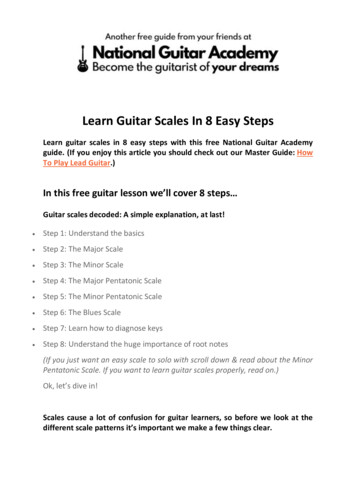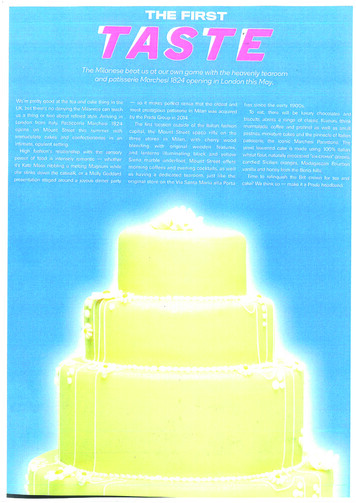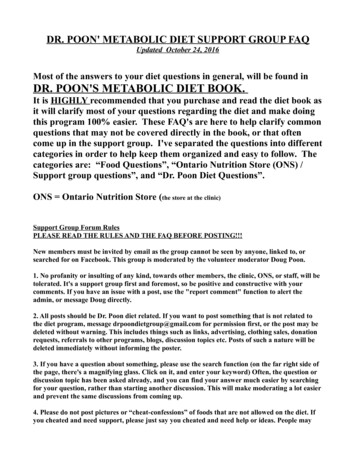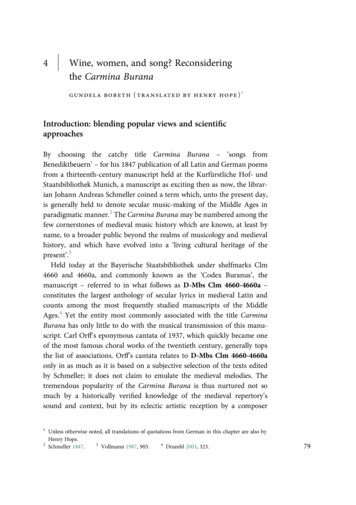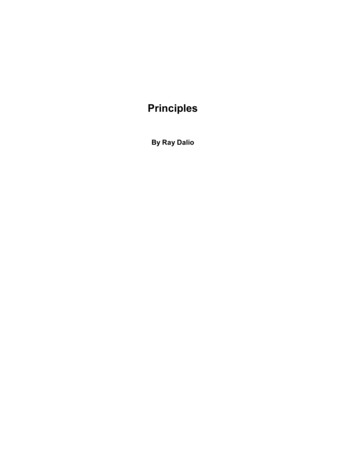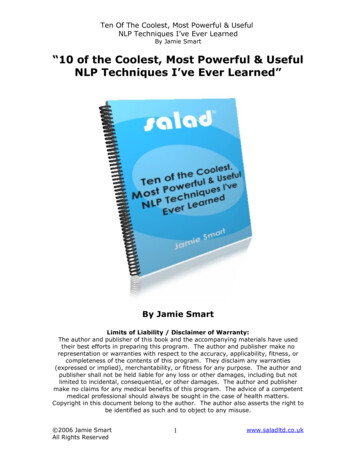
Transcription
Ten Of The Coolest, Most Powerful & UsefulNLP Techniques I’ve Ever LearnedBy Jamie Smart“10 of the Coolest, Most Powerful & UsefulNLP Techniques I’ve Ever Learned”By Jamie SmartLimits of Liability / Disclaimer of Warranty:The author and publisher of this book and the accompanying materials have usedtheir best efforts in preparing this program. The author and publisher make norepresentation or warranties with respect to the accuracy, applicability, fitness, orcompleteness of the contents of this program. They disclaim any warranties(expressed or implied), merchantability, or fitness for any purpose. The author andpublisher shall not be held liable for any loss or other damages, including but notlimited to incidental, consequential, or other damages. The author and publishermake no claims for any medical benefits of this program. The advice of a competentmedical professional should always be sought in the case of health matters.Copyright in this document belong to the author. The author also asserts the right tobe identified as such and to object to any misuse. 2006 Jamie SmartAll Rights Reserved1www.saladltd.co.uk
Ten Of The Coolest, Most Powerful & UsefulNLP Techniques I’ve Ever LearnedBy Jamie SmartTable of ContentsRead This First.3Who Is This E-book For?. 4What Is NLP?.5Why Learn NLP?.6#1 – Start Before You Start & Finish Before You Finish.7#2 - Take People Literally. 8#3 – Go There First. 10#4 - Just Start Talking.12#5 – Do It Before You Do It.14#6 – Use Your Peripheral Vision. 16#7 – Borrow Gestures.18#8 – Use The Meta-Model. 20#9 – Use The Milton Model. 22#10 – Eliminate Hesitation. 26More Information. 28About the Author.31 2006 Jamie SmartAll Rights Reserved2www.saladltd.co.uk
Ten Of The Coolest, Most Powerful & UsefulNLP Techniques I’ve Ever LearnedBy Jamie SmartRead This FirstWelcome to 10 of the Coolest, Most Powerful & Useful NLP Techniques I’ve EverLearned. My name’s Jamie Smart. I’m an NLP trainer, author, and creator of NLPCoaching CardsTM, Ericksonian Hypnosis CardsTM, and Irresistible Influence CardsTM,the world’s leading resources for learning the language of NLP, Hypnosis andInfluence. I’d like to say “thank-you” to you for reading this e-book. I’d also like toask you to please send this e-book to your friends and colleagues, because itwill help them, it will help me to reach more people, and because it will make youfeel good too! If you’ve been sent this e-book by someone else, then make surethat you sign up for the FREE NLP newsletter that accompanies it, here:http://www.saladltd.co.uk/tip signup.htmOnce you do, you will be sent new issues on a regular basis to learn from. It will onlytake a minute or two to read, but you’ll be amazed at the skills you start developingquickly.This book complements our NLP Coaching CardsTM, Ericksonian Hypnosis CardsTM, andIrresistible Influence CardsTM. I’ll be referring to the cards later, but when you buythe cards and get the patterns now, you can unlock the massive potential thisbook reveals immediately.If you want to really accelerate your learning, go to the Salad website and orderall three decks of SALAD NLP CARDS at a special discounted rate (These cardsare quite simply the fastest way there is to develop your skills in using the languageof NLP, Hypnosis and Influence. The insights you’ll be getting from the newslettercomplement the patterns on the cards, so when you have both, it will really turbocharge your learning. For more information about how you can learn fast just byplaying cards, click here 2006 Jamie SmartAll Rights Reserved3www.saladltd.co.uk
Ten Of The Coolest, Most Powerful & UsefulNLP Techniques I’ve Ever LearnedBy Jamie SmartWho Is This E-book For?This e-book is for people who are interested in helping themselves to resolve issuesand reach their goals more quickly and easily, and for helping others to do the same.It will also be of great value to people who want to massively increase their ability tocommunicate effectively. It will be of particular interest to executive coaches, lifecoaches, therapists, hypnotists, trainers, managers, salespeople, consultants,networkers, students of NLP, health-workers, doctors and other healers.IntroductionWhen I first started learning NLP, I dreamed of being able to do the magic that I hadheard about. Getting into rapport at a moment’s notice, wonders of sensory acuity,extraordinary leaps of intuition, wildly persuasive language patterns. I wanted all ofit, and I wanted it fast!I scrabbled about, buying books, going on training courses and practicing. I was likea man possessed! But when I look back on that time, I realise now that many of thethings which made the biggest difference were actually quite simple, and sometimescounter-intuitive.I’ve met lots of people who have been trained in NLP, but still aren’t getting the sortsof results that they want. And I’ve met others who are just starting out, and areoverwhelmed by the amount of information. I’ve met yet others who are doing well,and are always on the lookout for a new tool, technique, or way of thinking which willget them even better results. This is for all of you.As you read this you'll start to see ways that you can fine-tune and improve yourabilities right away. Read on and I'll show you ways you can accelerate yourlearning later. 2006 Jamie SmartAll Rights Reserved4www.saladltd.co.uk
Ten Of The Coolest, Most Powerful & UsefulNLP Techniques I’ve Ever LearnedBy Jamie SmartWhat Is NLP?NLP (Neuro-linguistic Programming) is the most powerful approach I’ve found forcommunications, change, and excellent performance. It has been widely applied,with often astonishing results, in fields as diverse as: BusinessCoachingSales & ationThe list goes on These days, most books on personal development will include at least some NLPtechniques, and it has been incorporated into most persuasion & influence trainingson at least some level. Some of the most dramatic accomplishments of the fieldinclude: AAAAfast (one session) phobia curelearnable model of the skills of exquisite communicatorsspelling strategy to transform the abilities of poor spellersfunctional model of the skills of great visionariesOne of the most profound ideas of NLP is that, if one person can do something, itshould be possible to find out what they’re doing and replicate it. NLP modelling is aunique approach for identifying and replicating the unconscious skills of excellentperformers (Eg. the ‘naturally talented’) then teaching them to others.The nameThe name of the field refers to (Neuro) the human nervous system, including thebrain and the five senses, (Linguistic) the verbal & non-verbal languages with whichwe communicate and (Programming) the ability to structure our neurological andlinguistic systems to achieve desired results.HistoryNeuro-Linguistic Programming (NLP) was developed starting in the early 1970s byRichard Bandler and John Grinder, when they set out to model the work of geniusesin the field of human communication and change. The term NLP is used to describeboth the approach to modelling that they used, and the powerful models ofcommunication and change they created (and have continued to develop.)The fundamentalsThe fundamentals of NLP are straightforward: 2006 Jamie SmartAll Rights Reserved5www.saladltd.co.uk
Ten Of The Coolest, Most Powerful & UsefulNLP Techniques I’ve Ever LearnedBy Jamie Smart1.Know what you want (Outcome / Direction)One of the key NLP questions is ‘What do you want?’. The human nervous systemcan be thought of as goal-seeking, and you tend to get what you focus on. Wellformed outcomes are an important tool for ensuring that you get more of what youwant in your life.2.Get the attention of the unconscious mind (Rapport)"The map is not the territory." You must start where the person you wish to influenceis (the ‘Present State’.) Rapport is the process of getting the attention and trust ofthe unconscious mind.3.Know whether you’re getting what you want (Sensory Acuity)Once you know where you want to go, you need to be able to notice (using one ormore senses) whether or not you are going there. Sensory acuity refers to the abilityto notice the signs that you are moving in the right direction (or otherwise.)4.Adjust what you’re doing accordingly (Behavioural Flexibility)"Insanity is doing the same thing over and over again, expecting a different result."When you notice that you are not getting what you want, you need the flexibility tochange what you are doing in order to get a different result. "Intelligence is theability to have a fixed goal and be flexible about how you achieve it."Why Learn NLP?By learning NLP you can: Learn to control your own state of mindDevelop powerfully persuasive communication skillsOvercome obstacles in business & in your personal lifeHelp others to get the results they wantHave more of the experiences you wantHave more success, happiness, joy and fulfillment in your lifeLearn the tools of freedom 2006 Jamie SmartAll Rights Reserved6www.saladltd.co.uk
Ten Of The Coolest, Most Powerful & UsefulNLP Techniques I’ve Ever LearnedBy Jamie SmartCool, Powerful, Useful NLP Technique#1 – Start Before You Start & Finish Before You FinishI used to love the TV show ‘Inspector Morse’. Each week, our opera-loving herowould use his intuition, reason, powers of observation and knowledge of the humancondition to solve seemingly insoluble mysteries and bring the villains to justice.Morse was a master of getting beneath the surface story someone was telling him,and getting the real story of what was going on. One of the strategies he used to dothis was to terminate the interview. He’d say “Well, I think that covers everything”,and would get up to leave. The person he was questioning would relax: “Phew! Gotaway with it.” Then, just as they were about to show Morse to the door, he’d turnround and say “Just one more thing ” then go for the jugular.While I’m not suggesting you go for clients’ jugulars, you can use the InspectorMorse strategy to reach people when their armour is off, when their defenses aredown. There are two ways I love doing this, and they’re incredibly simple: I startbefore I start, and I finish before I finish.Start before you startAt the beginning of a training course, a coaching session or a sales call, after we’vemade our introductions, I say something along the lines of “There’s some stuff I’dlike to cover before we begin ”Then I begin!People have their armour off before the formal ‘beginning’ of a session, and it’s agreat time to work with them. Personally, I never actually get to the point where weformally begin. I do all the work in either the ‘pre-beginning’ section, or after the endof the session. Which reminds me Finish before you finishLike Inspector Morse, you can finish before you finish. If you’re having difficultygetting to the point you want to, you can say “Well, I think that’s enough for today”,and get up to leave. Then say “Oh, just one more thing ” and start again. You willbe amazed at what can pop out when you finish before you finish. 2006 Jamie SmartAll Rights Reserved7www.saladltd.co.uk
Ten Of The Coolest, Most Powerful & UsefulNLP Techniques I’ve Ever LearnedBy Jamie SmartCool, Powerful, Useful NLP Technique#2 - Take People LiterallyI belong to a mastermind group, a team of 8 people who meet every month tosupport each other in achieving their goals and realising their dreams.At one of our meetings, a member of the group said that he wanted to lose someweight. When asked about it, he admitted that he didn’t feel very positive about it,as he’d been sticking to a Spartan diet for months, had exercised regularly, but justdidn’t seem to be able to shift it. He said “Deep down, I don’t really believe I’ll beable to do it”.As I listened to him, I noticed various things about the way he was using language todescribe his situation. Mind and body are one system, and the way people talk aboutproblems, goals and desires can reveal the structure of how they think about them.They way they think about them will determine the results they get, so I asked himsome questions. First, I asked him “Why is it like that?”The question “Why?” used to be banned in NLP circles, but it’s great for getting theperson’s story about a belief. He said “I just can’t see myself being slim.”Instantly, I knew what the problem was (as anyone with some experience of NLPwill!)One of the most useful things I ever learned was “Take people literally.” Mycolleague was giving me a literal description of what was taking place inside hisneuro-physiology. He was quite literally unable to create a mental image of himselfbeing the size and shape he wanted.The human nervous system is goal-seeking, and it will move towards whatever goalsyou put into it. The goal he’d been using was “I want to lose weight”. This presentsseveral problems:a)He was saying what he didn’t want (weight) instead of what he did want.Negatives are processed differently by neurology than they are in language (if I say“Don’t imagine a bacon sandwich”, you have to imagine it to understand what I’vesaid.) By setting his goal as losing weight, he was having to represent the weight tohimself in some way.b)People don’t like to lose things! We have been conditioned since we werechildren not to lose things, and if we do, to find them again.Stating his goal in this way, coupled with the fact that he didn’t have a mental imageof himself being slim, fit & healthy, meant that he kept getting what he didn’t want(his mental image was of him being the shape he already was).So I asked him “What would happen if you could see yourself being slim?” 2006 Jamie SmartAll Rights Reserved8www.saladltd.co.uk
Ten Of The Coolest, Most Powerful & UsefulNLP Techniques I’ve Ever LearnedBy Jamie SmartHis face brightened, and he said that would be great, and his eyes fixated out infront of him. I said something along the lines of “Just see yourself being the size andshape that you want to be, and feel how good that will feel, to see yourself in themirror, looking so good, and hear those appreciative comments from others, andyourself, about how good you look, feeling slim and fit and healthy.”I told him “You can spend some time in the next few days, imagining yourself beingthe size and shape you want to be. Then feel how you’ll feel when you’ve got whatyou want”.I received a phone call from him a few weeks later. After the meeting, he had spentabout 20 minutes visualising and imagining how it would be when he got to his idealweight, then continued as usual. When he rang, he reported that he was 8 poundslighter, after having stayed the same weight for months and months previously.While there is a valuable lesson in here about setting positive goals and visualisation,there is also a deeper learning. Take people literally, and they will give youinformation about exactly what’s going on inside them.In the past, if someone had said “I just can’t see myself being slim”, I would havetaken it as a metaphorical statement, and tried to convince them that they could etc.But our neurology has developed for the world of things & experience. When youtake people literally, they reveal a world of information about what’s going on insidethem.I once heard Richard Bandler say “People will tell you everything you need to know inthe first minute.” This is an example of that. Of course, you need to have open-nessto be able to hear it, and the questions to ask in the first place to get at the rightinformation.This is one of the secrets of becoming really good at NLP.If this makes sense to you, then check out our NLP Coaching Cards.They are one of the fastest, easiest ways there is for you to start to increase yourown abilities to do NLP with yourself and others. 2006 Jamie SmartAll Rights Reserved9www.saladltd.co.uk
Ten Of The Coolest, Most Powerful & UsefulNLP Techniques I’ve Ever LearnedBy Jamie SmartCool, Powerful, Useful NLP Technique#3 – Go There FirstOne way of thinking about NLP is as the process of helping people move fromwhatever their present set of circumstances is to some desired set of circumstances.The key to moving from one to the other is helping a person to access the resourcesnecessary to make the move.One of the most powerful resources is a person’s state of mind. Mind and body areone system, and the combination of the feeling a person is feeling and the way theyare thinking (pictures, sounds etc) can be referred to as their ‘state’.If you are relaxing in a hot bath, you are probably in a different state than the oneyou are in when you’re going for a run, giving a presentation, or about to kisssomeone for the first time.The ability to guide people into different states is one of the most powerful skills forcommunication and change that there is.Trance is a ‘feeling state’, in the same way as happiness, gratitude and love arefeeling states. One of the great things about feeling states is they are infectious, so ifyou want someone else to go into a certain state, just go there first yourself.The quickest way to get a punch on the nose is to start distributing them. Thequickest way to get a smile from someone is to start distributing them. Whateverstate you want the other person to go into, go there first yourself.So how exactly do you ‘go there first’? There are many different ways, and as youbegin to practice, you will start to discover the approaches that work most effectivelyfor you. Here are a few of them: One of the quickest and easiest ways to change your state of mind is to changeyour physiology. Jumping up and down, shaking your hands or beating your chestare all ways to break out of undesired states. By the same token, adopting thepostures and stances that you take when you are accessing certain states canactivate those states. Either sitting or standing, adopt the physiology (posture,gesture, head position, breathing rate, muscle tension) that you exhibit when youare in a certain state (E.g. trance, the zone, flow, relaxation, creativity etc.)Notice how quickly you start to enjoy experiencing the sensations of that state. “Fake it to make it.” Pretend. When you pretend to go into a certain state, yournervous system gets the idea very quickly, and the state soon manifests. You canpretend to be in whatever state you like: the more convincingly you do it, themore you will get into it (and vice versa). The more convincing you are toyourself, the more the other person will follow you into the state. 2006 Jamie SmartAll Rights Reserved10www.saladltd.co.uk
Ten Of The Coolest, Most Powerful & UsefulNLP Techniques I’ve Ever LearnedBy Jamie Smart An anchor is any representation in the human nervous system that triggers anyother representation. It is conceptually similar to Pavlovian conditioning (thinkbells and salivating dogs.) You can anchor yourself intentionally, for example:a) Think of an occasion when you had a highly pleasurable, positive or enjoyableexperience.b) See what you saw then (looking out through your own eyes), hear what youheard and feel what you felt.c) As you feel the sensations increase in intensity, squeeze the thumb andforefinger of your left hand gently together for a few moments, then releasethem.d) Now ‘break your state’ (E.g. by remembering what you had for lunchyesterday.) Wait a few moments.e) Squeeze your thumb and forefinger together again. The state will return.With practice, you will be able to go into the states you desire, quickly and easily,whenever you wish. When you’re in rapport with someone and you go into a certainstate, they will follow. 2006 Jamie SmartAll Rights Reserved11www.saladltd.co.uk
Ten Of The Coolest, Most Powerful & UsefulNLP Techniques I’ve Ever LearnedBy Jamie SmartCool, Powerful, Useful NLP Technique#4 - Just Start TalkingOne of the things I love doing on our NLP Practitioner and Master Practitionertrainings is getting people playing with Ericksonian Hypnosis CardsTM and IrresistibleInfluence CardsTM. It’s great for raising peoples’ energy in the notorious ‘after lunch’lull, creates a really fun learning environment, and the rate their linguistic skillsdevelop at is fantastic.But there’s always a challenge to overcome before their skills really start to take off People want to know what they’re going to say before they say it.I explain to them that language generation, word selection and grammar areunconscious functions; that your unconscious produces language automatically, inresponse to whatever communication goal you have set (and there’s always a goal inyour unconscious mind, whether you’re consciously aware of it or not).If you think back to your last telephone conversation, chances are you weren’tthinking consciously about what words you were going to say next, how to structurethe sentence, where to put the verbs etc. You have a goal in mind (whether you’reconsciously aware of it or not) and your unconscious finds the words, phrases andsentences to move you towards it.The key to becoming fluent with NLP language patterns is this: practice the patternsuntil you have integrated them at an unconscious level, then set a communicationgoal and start talking. You will start to hear the patterns emerging automatically andspontaneously.The problem is, people don’t want to make a mistake, or appear silly. So I say tothem “Imagine you’re in a learning laboratory, where the usual rules about socialintercourse are suspended. If you open your mouth and say ‘Arse, arse, spanky,spanky’, it doesn’t matter”. See, when you were a child learning to speak, you hadno concept of failure. You were merely experimenting, making sounds with yourmouth and vocal chords, and noticing what response you got.It’s the same with learning hypnotic language: you need to allow yourself theopportunity to make ‘mistakes’ in order to learn and grow.So anyway, I say to my Pracs & Master Pracs, “When you pick up your cards, startreading the phrase at the top of the card and let your unconscious fill in the blanks.”The key is to set a goal for your communication first. That way, your unconsciousknows to produce phrases that are in line with the goal you’ve set. If you don’tchoose a specific goal, you get whatever goal has been rattling around in yourunconscious (which can be to do with pretty much anything). I’ll give you a couple ofexamples:You might become aware of when you . 2006 Jamie SmartAll Rights Reserved12www.saladltd.co.uk
Ten Of The Coolest, Most Powerful & UsefulNLP Techniques I’ve Ever LearnedBy Jamie SmartYou might become aware of it, which presupposes it's already there, and allyou have to do to find out is the bit after the "when you". You might becomeaware of a deepening sense of trance when you focus your attention insideyourself. You might become aware of a new range of possibilities when youallow your unconscious to start generating solutions. You might becomeaware of an emerging sense of confidence as you practice these patternsrepeatedly. It's just a possibility!Or one of my personal favourites:What happens when you ?I'm only asking. But to find out what happens, you have to do it. What happens when you imagine yourself enjoying all the benefits of having made thischange? What happens when you imagine being able to use the patterns effortlessly?I use this all the time to great effect. To find out how this can work for you, do thefollowing: Read the full text of the pattern & description aloud. Set a goal for your communication (Eg. to get someone to go into a trance, relaxdeeply, feel good, learn quickly etc). Start reading the pattern (the line in bold) aloud, even though you don’t knowconsciously what you're going to say to fill in the blanks. Then be amazed as yourunconscious fills them in for you! Allow yourself the courtesy of not getting it perfect the first few times you do it,and enjoy the process of getting better and better at this as you practice.For the fastest way there is to learn to use hypnotic language quickly and effectively,you can get your own deck of Ericksonian Hypnosis CardsTM to practice with, becausethe fastest way to learn anything is by doing it. 2006 Jamie SmartAll Rights Reserved13www.saladltd.co.uk
Ten Of The Coolest, Most Powerful & UsefulNLP Techniques I’ve Ever LearnedBy Jamie SmartCool, Powerful, Useful NLP Technique#5 – Do It Before You Do ItWhenever I’m working with clients, either in a group situation or one-to-one, I’malways keen that they have the experience of success. I particularly want them tosucceed at the things I invite them to do, because these are the things that will helpthem experience greater success in other areas of their lives.The message I want to send them on every level is “You’re going to be able to doeverything that I ask you to do, so you can relax.”Here’s one of my favourite ways to do this: I get them to do it before I get them todo it.I know this sounds bizarre, so I’ll explain.Let’s say that I want someone to get into a very resourceful state, full of confidence& positivity. I could say to them “Remember a time when you felt reallyconfident & positive, then see what you saw, hear what you heard, & feelwhat you felt all over again.”This would work for some people, but others might feel under pressure, polarityrespond, or find it tricky in some way. So instead, here’s what I do I tell them a story. I describe an experience that gets them to access those states.I remember the first time that I successfully helped someone to eliminate a dogphobia. Part of the process of the fast phobia cure is stacking incredibly positivestates (including laughter, confidence and whatever else the person deemed useful).So I told dirty jokes to get her laughing, and told her stories about things that mademe feel really confident.See, when you hear someone else telling a story, your unconscious mind searchesfor relevant experiences to help you make sense of it. So when I told her storiesabout experiences where I felt incredibly confident; situations where I just knew theright thing to do, and felt good about it, she had to find reference experiences thatmade sense of that for her (albeit unconsciously).Then, it was just a matter of saying “Now, I’d like you to think of a time whenyou felt confident. It doesn’t have to be the most confident you’ve ever felt,just a time when you felt really confident.”There’s a trick in here. When I say “It doesn’t have to be the most confidentyou’ve ever felt”, a couple of things happen: If a person is feeling under pressure, this will relax them & let them know that Idon’t need a top performance from them. Just processing the sentence will get them to access (at least unconsciously) the 2006 Jamie SmartAll Rights Reserved14www.saladltd.co.uk
Ten Of The Coolest, Most Powerful & UsefulNLP Techniques I’ve Ever LearnedBy Jamie Smartmost confident they’ve ever felt, for purposes of comparison. Polarity responders (people who automatically want to do the opposite of whatyou tell them) go “Oh yeah! You can’t stop me from feeling the most confidentI’ve ever felt if I want to!” Which is, of course, just what I wantAnyway, when I’d finished doing the phobia cure with her, we went out to find a dogto test it with. She was fine! It worked! She felt great! I felt amazing! The feeling ofhaving helped someone make such a powerful change in their lives wasextraordinary, and I felt great about my skills, full of a desire to learn more andexplore further. It was an incredibly positive experience.So, as you’ve read this, you’ve been making sense of the story I’ve been telling you.In order to understand it, you’ve been unconsciously referencing your ownexperiences of learning, achievement & success. At this point, if I were to say“Remember a time when you felt really confident & positive, then see whatyou saw, hear what you heard, & feel what you felt all over again.” you’d bemuch more likely to access it easily, wouldn’t you? That’s because I did it before Idid it. Or rather, I got you to do it before I got you to do it.One of the keys to doing it before you do it is becoming a master of stories. You canlearn how to become a master of stories when you download MetaphoricallySpeaking, a recording of a one-day training focused entirely on stories &metaphors. Learn more here. 2006 Jamie SmartAll Rights Reserved15www.saladltd.co.uk
Ten Of The Coolest, Most Powerful & UsefulNLP Techniques I’ve Ever LearnedBy Jamie SmartCool, Powerful, Useful NLP Technique#6 – Use Your Peripheral VisionJohn Grinder (co-developer of NLP) once said that he’d identified three mainobstacles to mastery of any skill:-over-reliance on focal visioninternal dialoguea feeling of hesitationThis seems to be particularly true when it comes to learning NLP, which relies soheavily on your ability to perceive a much wider view of things and act instinctively.By finding ways to overcome or eliminate these obstacles, you can start to reallyincrease your abil
This book complements our NLP Coaching CardsTM, Ericksonian Hypnosis CardsTM, and Irresistible Influence CardsTM. I’ll be referring to the cards later, but when you buy the cards and get the patterns now, you can un
